Unraveling the Knowledge Roadmap of Building Policy Mixes: A Scientometric Analysis
Abstract
:1. Introduction
2. Materials and Methods
2.1. Research Methods
2.2. Data Collection
3. Results and Discussion
3.1. Sample Distributions
3.2. Keywords Co-Occurrence Analysis
3.3. Keywords Clustering Analysis
3.4. Literature Co-Citation Analysis
3.5. Evolutionary Trend Analysis
4. A Roadmap for BPM
- Research hotpots and frontiers
- Deepened insight into interdisciplinary policy mixes
- Methodology
- Research prospects
5. Conclusions
Author Contributions
Funding
Institutional Review Board Statement
Informed Consent Statement
Data Availability Statement
Conflicts of Interest
References
- Haonan, Z.; Kasun, H.; Hirushie, K.; Haibo, F.; Rehan, S. Research on policy strategies for implementing energy retrofits in the residential buildings. Build. Eng. 2021, 43, 103161. [Google Scholar]
- Huang, H.; Wang, H.; Hu, Y.-J.; Li, C.; Wang, X. The development trends of existing building energy conservation and emission reduction—A comprehensive review. Energy Rep. 2022, 8, 13170–13188. [Google Scholar] [CrossRef]
- Liu, G.; Ye, K.; Tan, Y.; Huang, Z.; Li, X. Factors influencing homeowners’ housing renovation decision-making: Towards a holistic understanding. Energy Build. 2022, 254, 111568. [Google Scholar] [CrossRef]
- Miezis, M.; Zvaigznitis, K.; Stancioff, N.; Soeftestad, L. Climate Change and Buildings Energy Efficiency—The Key Role of Residents. Environ. Clim. Technol. 2016, 17, 30–43. [Google Scholar] [CrossRef]
- Agency, I.E. Greenhouse Gas Emissions from Energy Data Explorer. Available online: https://www.iea.org/articles/greenhouse-gas-emissions-from-energy-data-explorer (accessed on 18 June 2022).
- Zhang, J.; Li, H.; Olanipekun, A.O.; Bai, L. A successful delivery process of green buildings: The project owners’ view, motivation and commitment. Renew. Energy 2019, 138, 651–658. [Google Scholar] [CrossRef]
- Park, B.R.; Chung, M.H. Analysis of the additional energy-saving potential of residential buildings after mandatory zero-energy buildings to achieve carbon neutrality in South Korea. Build. Environ. 2023, 228, 109908. [Google Scholar] [CrossRef]
- Asadi, E.; Silva, M.G.d.; Antunes, C.H.; Dias, L.; Glicksman, L. Multi-objective optimization for building retrofit: A model using genetic algorithm and artificial neural network and an application. Energy Build. 2014, 81, 444–456. [Google Scholar] [CrossRef]
- Martiskainen, M.; Kivimaa, P. Role of knowledge and policies as drivers for low-energy housing: Case studies from the United Kingdom. J. Clean. Prod. 2019, 215, 1402–1414. [Google Scholar] [CrossRef]
- Kore, S.D.; Balaji, N.; Sudarsan, J.S. Feasibility study of adopting green materials in construction by stake holder‘s perception using ANOVA based quantitative analysis technique. Mater. Today Proc. 2023, 92, 1688–1693. [Google Scholar] [CrossRef]
- Zilong, W.; Shilei, Q. Can “energy saving and emission reduction” demonstration city selection actually contribute to pollution abatement in China? Sustain. Prod. Consum. 2021. prepublish. [Google Scholar]
- Maerz, S.; Bierwirth, A.; Schuele, R. Mixed-Method Research to Foster Energy Efficiency Investments by Small Private Landlords in Germany. Sustainability 2020, 12, 1702. [Google Scholar] [CrossRef]
- Edmondson, D.L.; Rogge, K.S.; Kern, F. Zero carbon homes in the UK? Analysing the co-evolution of policy mix and socio-technical system. Environ. Innov. Soc. Transit. 2020, 35, 135–161. [Google Scholar] [CrossRef]
- Sutantio, A.; Anwar, N.; Wiguna, I.P.A.; Suryani, E. A System Dynamics Model of Sustainable Construction for High rise Residential Projects in Developing Countries: Case of Indonesia. Open Civ. Eng. J. 2022, 16, 1495–1874. [Google Scholar] [CrossRef]
- Rosenow, J.; Fawcett, T.; Eyre, N.; Oikonomou, V. Energy efficiency and the policy mix. Build. Res. Inf. 2016, 44, 562–574. [Google Scholar] [CrossRef]
- Liu, G.; Li, X.; Tan, Y.; Zhang, G. Building green retrofit in China: Policies, barriers and recommendations. Energy Policy 2020, 139, 111356. [Google Scholar] [CrossRef]
- Flanagan, K.; Uyarra, E.; Laranja, M. Reconceptualising the ‘policy mix’ for innovation. Res. Policy 2011, 40, 702–713. [Google Scholar] [CrossRef]
- Ringeling, A.B. Instruments in Four: The Elements of Policy Design. In Designing Government; Pearl, E., Margaret, M.H., Michael, H., Eds.; McGill-Queen’s University Press: Montreal, QC, Canada, 2005; pp. 185–202. [Google Scholar]
- Schwarz, M.; Knoeri, C. Accelerating the Diffusion of Energy-Efficient Building Technologies with Policies—The Case of Switzerland; International Conference on Climate Resilient Cities—Energy Efficiency and Renewables in the Digital Era (CISBAT); Ecole Polytechnique Fed Lausanne, Solar Energy & Building Phys. Lab.: Lausanne, Switzerland, 2019. [Google Scholar]
- Braungardt, S.; Buerger, V.; Koehler, B. Carbon Pricing and Complementary Policies-Consistency of the Policy Mix for Decarbonizing Buildings in Germany. Energies 2021, 14, 7143. [Google Scholar] [CrossRef]
- Rogge, K.S.; Reichardt, K. Policy mixes for sustainability transitions: An extended concept and framework for analysis. Res. Policy 2016, 45, 132–147. [Google Scholar] [CrossRef]
- Prasad, K.V.; Vasugi, V.; Senthil Kumaran, G. Application of 3D printing concepts in the Architecture Engineering and Construction (AEC) industry—A scientometric review. Mater. Today Proc. 2023. [Google Scholar] [CrossRef]
- Luo, W.; Sandanayake, M.; Hou, L.; Tan, Y.; Zhang, G. A systematic review of green construction research using scientometrics methods. J. Clean. Prod. 2022, 366, 132710. [Google Scholar] [CrossRef]
- He, Q.; Wang, G.; Luo, L.; Shi, Q.; Xie, J.; Meng, X. Mapping the managerial areas of Building Information Modeling (BIM) using scientometric analysis. Int. J. Proj. Manag. 2017, 35, 670–685. [Google Scholar] [CrossRef]
- Li, J.; Goerlandt, F.; Reniers, G. An overview of scientometric mapping for the safety science community: Methods, tools, and framework. Saf. Sci. 2021, 134, 105093. [Google Scholar] [CrossRef]
- Pollack, J.; Adler, D. Emergent trends and passing fads in project management research: A scientometric analysis of changes in the field. Int. J. Proj. Manag. 2015, 33, 236–248. [Google Scholar] [CrossRef]
- Chen, Y.; Chen, C.M.; Liu, Z.Y.; Hu, Z.G.; Wang, X.W. The methodology function of CiteSpace mapping knowledge domains. Stud. Sci. Sci. 2015, 33, 242–253. [Google Scholar]
- Barroso, M.; Laborda, J. Digital transformation and the emergence of the Fintech sector: Systematic literature review. Digit. Bus. 2022, 2, 100028. [Google Scholar] [CrossRef]
- Jacomy, M.; Venturini, T.; Heymann, S.; Bastian, M. ForceAtlas2, a Continuous Graph Layout Algorithm for Handy Network Visualization Designed for the Gephi Software. PLoS ONE 2014, 9, e98679. [Google Scholar] [CrossRef] [PubMed]
- Luo, T.; Tan, Y.; Langston, C.; Xue, X. Mapping the knowledge roadmap of low carbon building: A scientometric analysis. Energy Build. 2019, 194, 163–176. [Google Scholar] [CrossRef]
- He, C.; Hou, Y.; Ding, L.; Li, P. Visualized literature review on sustainable building renovation. J. Build. Eng. 2021, 44, 102622. [Google Scholar] [CrossRef]
- Li, Y.; Li, M.; Sang, P.; Chen, P.-H.; Li, C. Stakeholder studies of green buildings: A literature review. J. Build. Eng. 2022, 54, 104667. [Google Scholar] [CrossRef]
- Xu, X.; Yu, H.; Sun, Q.; Tam, V.W.Y. A critical review of occupant energy consumption behavior in buildings: How we got here, where we are, and where we are headed. Renew. Sustain. Energy Rev. 2023, 182, 113396. [Google Scholar] [CrossRef]
- Chappin, E.J.L.; Ligtvoet, A. Transition and transformation: A bibliometric analysis of two scientific networks researching socio-technical change. Renew. Sustain. Energy Rev. 2014, 30, 715–723. [Google Scholar] [CrossRef]
- Falagas, M.E.; Pitsouni, E.I.; Malietzis, G.A.; Pappas, G. Comparison of PubMed, Scopus, Web of Science, and Google Scholar: Strengths and weaknesses. FASEB J. Off. Publ. Fed. Am. Soc. Exp. Biol. 2008, 22, 338–342. [Google Scholar] [CrossRef] [PubMed]
- Badenhorst, A.; Mansoori, P.; Chan, K.Y. Assessing global, regional, national and sub-national capacity for public health research: A bibliometric analysis of the Web of Science (TM) in 1996–2010. J. Glob. Health 2016, 6, 010504. [Google Scholar] [CrossRef] [PubMed]
- Small, H. Co-citation in the scientific literature: A new measure of the relationship between two. J. Am. Soc. Inf. Sci. 1973, 24, 265–269. [Google Scholar] [CrossRef]
- Liu, G.; Tan, Y.; Huang, Z. Knowledge Mapping of Homeowners’ Retrofit Behaviors: An Integrative Exploration. Buildings 2021, 11, 273. [Google Scholar] [CrossRef]
- Su, H.-N.; Lee, P.-C. Mapping knowledge structure by keyword co-occurrence: A first look at journal papers in Technology Foresight. Scientometrics 2010, 85, 65–79. [Google Scholar] [CrossRef]
- Chen, C.; Dubin, R.; Kim, M.C. Emerging trends and new developments in regenerative medicine: A scientometric update (2000–2014). Expert. Opin. Biol. Ther. 2014, 14, 1295–1317. [Google Scholar] [CrossRef]
- Chen, R.; Zhang, R.; Han, H. Where has carbon footprint research gone? Ecol. Indic. 2021, 120, 106882. [Google Scholar] [CrossRef]
- Zhang, M.; Li, H.; Tian, S. Visual analysis of machine learning methods in the field of ergonomics—Based on Cite Space V. Int. J. Ind. Ergon. 2023, 93, 103395. [Google Scholar] [CrossRef]
- Xiang, C.; Wang, Y.; Liu, H. A scientometrics review on nonpoint source pollution research. Ecol. Eng. 2017, 99, 400–408. [Google Scholar] [CrossRef]
- Li, X.; Wu, P.; Shen, G.Q.; Wang, X.; Teng, Y. Mapping the knowledge domains of Building Information Modeling (BIM): A bibliometric approach. Autom. Constr. 2017, 84, 195–206. [Google Scholar] [CrossRef]
- Cho, C.; Jeong, Y.-S. Is Energy Policy on the Right Track for the Climate Target in the Korean Building Sector? J. Asian Archit. Build. Eng. 2017, 16, 431–437. [Google Scholar] [CrossRef]
- Li, J.; Shui, B. A comprehensive analysis of building energy efficiency policies in China: Status quo and development perspective. J. Clean. Prod. 2015, 90, 326–344. [Google Scholar] [CrossRef]
- Ziemele, J.; Cilinskis, E.; Zogla, G.; Gravelsins, A.; Blumberga, A.; Blumberga, D. Impact of economical mechanisms on CO2 emissions from non-ETS district heating in Latvia using system dynamic approach. Int. J. Energy Environ. Eng. 2018, 9, 111–121. [Google Scholar] [CrossRef]
- Chen, Y.; Li, Z.; Xu, J.; Liu, Y.; Meng, Q. How Does the Government Policy Combination Prevents Greenwashing in Green Building Projects? An Evolutionary Game Perspective. Buildings 2023, 13, 917. [Google Scholar] [CrossRef]
- Sheng, W.; Wen, B.; Zhang, L. Envelope performance of residential building in cool, warm and hot climatic zones: Results from self-designed in-situ monitoring campaigns. Energy Build. 2021, 232, 110655. [Google Scholar] [CrossRef]
- Fotiou, T.; Capros, P.; Fragkos, P. Policy Modelling for Ambitious Energy Efficiency Investment in the EU Residential Buildings. Energies 2022, 15, 2233. [Google Scholar] [CrossRef]
- Gan, X.; Yan, K.; Wen, T. Using fuzzy cognitive maps to develop policy strategies for the development of green rural housing: A case study in China. Technol. Forecast. Soc. Change 2023, 192, 122590. [Google Scholar] [CrossRef]
- Yang, Z.; Chen, H.; Mi, L.; Li, P.; Qi, K. Green building technologies adoption process in China: How environmental policies are reshaping the decision-making among alliance-based construction enterprises? Sustain. Cities Soc. 2021, 73, 103122. [Google Scholar] [CrossRef]
- Jeddi Yeganeh, A.; McCoy, A.P.; Hankey, S. Green Affordable Housing: Cost-Benefit Analysis for Zoning Incentives. Sustainability 2019, 11, 6269. [Google Scholar] [CrossRef]
- Gram-Hanssen, K.; Jensen, J.O.; Friis, F. Local strategies to promote energy retrofitting of single-family houses. Energy Effic. 2018, 11, 1955–1970. [Google Scholar] [CrossRef]
- Florencia Zabaloy, M.; Yesica Recalde, M.; Guzowski, C. Are energy efficiency policies for household context dependent? A comparative study of Brazil, Chile, Colombia and Uruguay. Energy Res. Soc. Sci. 2019, 52, 41–54. [Google Scholar] [CrossRef]
- Webber, P.; Gouldson, A.; Kerr, N. The impacts of household retrofit and domestic energy efficiency schemes: A large scale, ex post evaluation. Energy Policy 2015, 84, 35–43. [Google Scholar] [CrossRef]
- Segal, E.; Feitelson, E.; Goulden, S.; Razin, E.; Rein-Sapir, Y.; Kagan, E.J.; Negev, M. Residential seismic retrofitting: Contextualizing policy packages to local circumstances. Int. J. Disaster Risk Reduct. 2022, 81, 103264. [Google Scholar] [CrossRef]
- Chen, S.; Mao, H.; Feng, Z. Political uncertainty and firm entry: Evidence from Chinese manufacturing industries. J. Bus. Res. 2020, 120, 16–30. [Google Scholar] [CrossRef]
- Choi, S.-j.; Liu, H.; Yin, J.; Qi, Y.; Lee, J.Y. The effect of political turnover on firms’ strategic change in the emerging economies: The moderating role of political connections and financial resources. J. Bus. Res. 2021, 137, 255–266. [Google Scholar] [CrossRef]
- Xing, M.; Cao, J.; Cao, D. Impacts of Policy Mix Comprehensiveness on BIM Implementation: Moderating Effects of Environmental State and Response Uncertainty. J. Constr. Eng. Manag. 2023, 149, 04022171. [Google Scholar] [CrossRef]
- Schiappacasse, P.; Mueller, B.; Le Thuy, L.; Wirth, P. Construction Aggregates and Environmental Policy Integration in a One-Party State: The Case of Hoa Binh, Vietnam. Sustainability 2020, 12, 6890. [Google Scholar] [CrossRef]
- Steurer, R.; Clar, C. Is decentralisation always good for climate change mitigation? How federalism has complicated the greening of building policies in Austria. Policy Sci. 2015, 48, 85–107. [Google Scholar] [CrossRef]
- Kangas, H.-L.; Lazarevic, D.; Kivimaa, P. Technical skills, disinterest and non-functional regulation: Barriers to building energy efficiency in Finland viewed by energy service companies. Energy Policy 2018, 114, 63–76. [Google Scholar] [CrossRef]
- Heikkilä, M.; Kuivaniemi, L. Ecosystem Under Construction: An Action Research Study on Entrepreneurship in a Business Ecosystem. Technol. Innov. Manag. Rev. 2012, 2, 18–24. [Google Scholar] [CrossRef]
- Tovar Reaños, M.A.; Meier, D.; Curtis, J.; Pillai, A. The role of energy, financial attitudes and environmental concerns on perceived retrofitting benefits and barriers: Evidence from Irish home owners. Energy Build. 2023, 297, 113448. [Google Scholar] [CrossRef]
- Baranzini, A.; van den Bergh, J.C.J.M.; Carattini, S.; Howarth, R.B.; Padilla, E.; Roca, J. Carbon pricing in climate policy: Seven reasons, complementary instruments, and political economy considerations. Clim. Chang. 2017, 8, e462. [Google Scholar] [CrossRef]
- Poncin, S. Energy Policies for Eco-Friendly Households in Luxembourg: A Study Based on the LuxHEI Model. Environ. Model. Assess. 2021, 26, 37–61. [Google Scholar] [CrossRef]
- Sharma, R.; Malaviya, P. Ecosystem services and climate action from a circular bioeconomy perspective. Renew. Sustain. Energy Rev. 2023, 175, 113164. [Google Scholar] [CrossRef]
- Dietz, T.; Rubio Jovel, K.; Deciancio, M.; Boldt, C.; Börner, J. Towards effective national and international governance for a sustainable bioeconomy: A global expert perspective. EFB Bioeconomy J. 2023, 3, 100058. [Google Scholar] [CrossRef]
- Li, J.; Colombier, M. Managing carbon emissions in China through building energy efficiency. J. Environ. Manag. 2009, 90, 2436–2447. [Google Scholar] [CrossRef]
- Jones, P.; Hou, S.S.; Li, X. Towards zero carbon design in offices: Integrating smart facades, ventilation, and surface heating and cooling. Renew. Energy 2015, 73, 69–76. [Google Scholar] [CrossRef]
- Chitnis, M.; Sorrell, S.; Druckman, A.; Firth, S.K.; Jackson, T. Turning lights into flights: Estimating direct and indirect rebound effects for UK households. Energy Policy 2013, 55, 234–250. [Google Scholar] [CrossRef]
- Kelemen, A.; Mzavanadze, N.; Ürge-Vorsatz, D. Literature Review on Social Welfare Impacts of Energy Efficiency Improvement Actions, 3rd ed.; COMBI: Manchester, UK, 2015; pp. 4–19. [Google Scholar]
- Zhang, M.; Wang, M.; Jin, W.; Xia-Bauer, C. Managing energy efficiency of buildings in China: A survey of energy performance contracting (EPC) in building sector. Energy Policy 2018, 114, 13–21. [Google Scholar] [CrossRef]
- Bonifaci, P.; Copiello, S. Incentive Policies for Residential Buildings Energy Retrofit: An Analysis of Tax Rebate Programs in Italy. In Smart and Sustainable Planning for Cities and Regions: Results of SSPCR 2017; Springer: Cham, Switzerland, 2018; pp. 267–279. [Google Scholar] [CrossRef]
- Liang, X.; Yu, T.; Hong, J.; Shen, G.Q. Making incentive policies more effective: An agent-based model for energy-efficiency retrofit in China. Energy Policy 2019, 126, 177–189. [Google Scholar] [CrossRef]
- Novikova, A.; Amecke, H.; Neuhoff, K.; Stelmakh, K.; Kiss, B.; Rohde, C.; Dunkelberg, E.; Weiß, J.; Matschoss, K.; Darby, S. Information tools for energy demand reduction in existing residential buildings. Clim. Policy Initiat. 2011, 32. (CPI Report). Available online: https://climatepolicyinitiative.org/wp-content/uploads/2011/12/Information-Tools-for-Energy-Demand-Reduction.pdf (accessed on 18 June 2022).
- Jia, L.; Qian, Q.; Meijer, F.; Visscher, H. How information stimulates homeowners’ cooperation in residential building energy retrofits in China. Energy Policy 2021, 157, 112504. [Google Scholar] [CrossRef]
- Bürger, V.; Klinski, S.; Lehr, U.; Leprich, U.; Nast, M.; Ragwitz, M. Policies to support renewable energies in the heat market. Energy Policy 2008, 36, 3150–3159. [Google Scholar] [CrossRef]
- Kranzl, L.; Brakhage, A.; Gürtler, P.; Pett, J.; Ragwitz, M.; Stadler, M. Integrating Policies for Renewables and Energy Efficiency: Comparing Results from Germany, Luxembourg and Northern Ireland; 2007; Volume 1, pp. 61–72. Available online: https://www.eceee.org/library/conference_proceedings/eceee_Summer_Studies/2007/Panel_1/1.159/ (accessed on 18 June 2022).
- Stadler, M.; Kranzl, L.; Huber, C.; Haas, R.; Tsioliaridou, E. Policy strategies and paths to promote sustainable energy systems—The dynamic Invert simulation tool. Energy Policy 2007, 35, 597–608. [Google Scholar] [CrossRef]
- Kranzl, L.; Hummel, M.; Mueller, A.; Steinbach, J. Renewable heating: Perspectives and the impact of policy instruments. Energy Policy 2013, 59, 44–58. [Google Scholar] [CrossRef]
- Kranzl, L.; Kalt, G.; Müller, A.; Hummel, M.; Egger, C.; Öhlinger, C.; Dell, G.J.E.P. Renewable energy in the heating sector in Austria with particular reference to the region of Upper Austria. Energy Policy 2013, 59, 17–31. [Google Scholar] [CrossRef]
- Yuan, H. A SWOT analysis of successful construction waste management. J. Clean. Prod. 2013, 39, 1–8. [Google Scholar] [CrossRef]
- Lu, W.; Yuan, H. Investigating waste reduction potential in the upstream processes of offshore prefabrication construction. Renew. Sustain. Energy Rev. 2013, 28, 804–811. [Google Scholar] [CrossRef]
- Tam, V.W.Y.; Tam, C.M.; Ng, W.C.Y. On prefabrication implementation for different project types and procurement methods in Hong Kong. J. Eng. Des. Technol. 2007, 5, 68–80. [Google Scholar] [CrossRef]
- Aye, L.; Ngo, T.; Crawford, R.H.; Gammampila, R.; Mendis, P. Life cycle greenhouse gas emissions and energy analysis of prefabricated reusable building modules. Energy Build. 2012, 47, 159–168. [Google Scholar] [CrossRef]
- Jaillon, L.; Poon, C.S.; Chiang, Y.H. Quantifying the waste reduction potential of using prefabrication in building construction in Hong Kong. Waste Manag. 2009, 29, 309–320. [Google Scholar] [CrossRef] [PubMed]
- Tam, C.M.; Tam, V.W.Y.; Chan, J.K.W.; Ng, W.C.Y. Use of Prefabrication to Minimize Construction Waste—A Case Study Approach. Int. J. Constr. Manag. 2005, 5, 91–101. [Google Scholar] [CrossRef]
- Koskela, L. Lean Production in Construction. In Proceedings of the 10th ISARC, Houston, TX, USA, 24–26 May 1993; pp. 47–54. [Google Scholar] [CrossRef]
- Carvajal-Arango, D.; Bahamón-Jaramillo, S.; Aristizábal-Monsalve, P.; Vásquez-Hernández, A.; Botero, L.F.B. Relationships between lean and sustainable construction: Positive impacts of lean practices over sustainability during construction phase. J. Clean. Prod. 2019, 234, 1322–1337. [Google Scholar] [CrossRef]
- Atwa, D.M.S. Quality Assurance in Construction as a Sustainability Approach. Environ. Sci. Eng. 2017, 6, 1–14. [Google Scholar]
- Alsaray, S.; Alsaraj, W.; Abass, Z. Effect of Iron Filings on the Mechanical Properties of Different Types of Sustainable Concrete. Open Civ. Eng. J. 2018, 12, 441–457. [Google Scholar] [CrossRef]
- Iwaro, J.; Mwasha, A. A review of building energy regulation and policy for energy conservation in developing countries. Energy Policy 2010, 38, 7744–7755. [Google Scholar] [CrossRef]
- Zhao, X.; Wang, J.; Wei, M.; Lai, Z.; Fan, M.; Zhao, J.; Pan, B.; Zhao, Y.; Li, X.; Zhao, Q. Optically stimulated luminescence dating of Holocene palaeoflood deposits in the middle reach of the Yongding River, China. Quat. Int. 2017, 453, 37–47. [Google Scholar] [CrossRef]
- Chen, Y.; Fang, S.; Börner, K. Mapping the development of scientometrics 2002–2008. Libr. Inf. Sci. Res. 2011, 3, 131–146. [Google Scholar]
- Mahala, A.; Singh, R. Research output of Indian universities in sciences (2015–2019): A scientometric analysis. Libr. Hi Tech. 2021, 39, 984–1000. [Google Scholar] [CrossRef]
- Kivimaa, P.; Kern, F. Creative destruction or mere niche support? Innovation policy mixes for sustainability transitions. Res. Policy 2016, 45, 205–217. [Google Scholar] [CrossRef]
- Smith, A.; Raven, R. What is protective space? Reconsidering niches in transitions to sustainability. Res. Policy 2012, 41, 1025–1036. [Google Scholar] [CrossRef]
- Palm, J.; Reindl, K. Understanding barriers to energy-efficiency renovations of multifamily dwellings. Energy Effic. 2018, 11, 53–65. [Google Scholar] [CrossRef]
- Charlier, D. Energy efficiency investments in the context of split incentives among French households. Energy Policy 2015, 87, 465–479. [Google Scholar] [CrossRef]
- Shapiro, S. The realpolitik of building codes: Overcoming practical limitations to climate resilience. Build. Res. Inf. 2016, 44, 490–506. [Google Scholar] [CrossRef]
- Wieczorek, A.J.; Hekkert, M.P. Systemic instruments for systemic innovation problems: A framework for policy makers and innovation scholars. Sci. Public Policy 2012, 39, 74–87. [Google Scholar] [CrossRef]
- Weber, K.M.; Rohracher, H. Legitimizing research, technology and innovation policies for transformative change: Combining insights from innovation systems and multi-level perspective in a comprehensive ‘failures’ framework. Res. Policy 2012, 41, 1037–1047. [Google Scholar] [CrossRef]
- Kriström, B.; Wibe, S. Environmental Policy in Sweden; Social Science Electronic Publishing: Rochester, NY, USA, 1997. [Google Scholar]
- Van Der Heijden, J. Privatisation of building code enforcement: A comparative study of regimes in Australia and Canada. Int. J. Law. Built Environ. 2010, 2, 60–75. [Google Scholar] [CrossRef]
- Kalt, G.; Kranzl, L.; Haas, R. Long-term strategies for an efficient use of domestic biomass resources in Austria. Biomass Bioenergy 2010, 34, 449–466. [Google Scholar] [CrossRef]
- Li, J.; Li, L. Research on Simulation of Promotion Policies for New Technology Application in Construction Industry Based on System Dynamics. In Proceedings of the ICCREM 2019, Banff, AB, Canada, 21–24 May 2019; pp. 144–152. [Google Scholar]
- Kranzl, L.; Stadler, M.; Huber, C.; Haas, R.; Ragwitz, M.; Brakhage, A.; Gula, A.; Figorski, A. Deriving efficient policy portfolios promoting sustainable energy systems—Case studies applying invert simulation tool. Renew. Energy 2006, 31, 2393–2410. [Google Scholar] [CrossRef]
- Jahed, N.; Aktaş, Y.D.; Rickaby, P.; Bilgin Altınöz, A.G. Policy Framework for Energy Retrofitting of Built Heritage: A Critical Comparison of UK and Turkey. Atmosphere 2020, 11, 674. [Google Scholar] [CrossRef]
- Kern, F.; Kivimaa, P.; Martiskainen, M. Policy packaging or policy patching? The development of complex energy efficiency policy mixes. Energy Res. Soc. Sci. 2017, 23, 11–25. [Google Scholar] [CrossRef]
- Jishi, W.-G.; Fang, J.-B.; Li, J. A bibliometric analysis and visualization of research on heart failure complicated with malnutrition. Front. Nurs. 2023, 10, 413–426. [Google Scholar] [CrossRef]
- Yılmaz, Y.; Seyis, S. Mapping the scientific research of the life cycle assessment in the construction industry: A scientometric analysis. Build. Environ. 2021, 204, 108086. [Google Scholar] [CrossRef]
- Nascimento, L.; Kuramochi, T.; Iacobuta, G.; den Elzen, M.; Fekete, H.; Weishaupt, M.; van Soest, H.L.; Roelfsema, M.; De Vivero-Serrano, G.; Lui, S.; et al. Twenty years of climate policy: G20 coverage and gaps. Clim. Policy 2022, 22, 158–174. [Google Scholar] [CrossRef]
- Judson, E.P.; Maller, C. Housing renovations and energy efficiency: Insights from homeowners’ practices. Build. Res. Inf. 2014, 42, 501–511. [Google Scholar] [CrossRef]
- Murphy, L.; Meijer, F.; Visscher, H. A qualitative evaluation of policy instruments used to improve energy performance of existing private dwellings in the Netherlands. Energy Policy 2012, 45, 459–468. [Google Scholar] [CrossRef]
- Seebauer, S.; Friesenecker, M.; Eisfeld, K. Integrating climate and social housing policy to alleviate energy poverty: An analysis of targets and instruments in Austria. Energy Sources Part B-Econ. Plan. Policy 2019, 14, 304–326. [Google Scholar] [CrossRef]
- Nykamp, H. Policy Mix for a Transition to Sustainability: Green Buildings in Norway. Sustainability 2020, 12, 446. [Google Scholar] [CrossRef]
- Urge-Vorsatz, D.; Koeppel, S.; Mirasgedis, S. Appraisal of policy instruments for reducing buildings’ CO2 emissions. Build. Res. Inf. 2007, 35, 458–477. [Google Scholar] [CrossRef]
- Ma, W.; de Jong, M.; de Bruijne, M.; Mu, R. Mix and match: Configuring different types of policy instruments to develop successful low carbon cities in China. J. Clean. Prod. 2021, 282, 125399. [Google Scholar] [CrossRef]
- Toller, S.; Wadeskog, A.; Finnveden, G.; Malmqvist, T.; Carlsson, A. Energy Use and Environmental Impacts of the Swedish Building and Real Estate Management Sector. J. Ind. Ecol. 2011, 15, 394–404. [Google Scholar] [CrossRef]
- Casado-Asensio, J.; Steurer, R. Mitigating climate change in a federal country committed to the Kyoto Protocol: How Swiss federalism further complicated an already complex challenge. Policy Sci. 2016, 49, 257–279. [Google Scholar] [CrossRef]

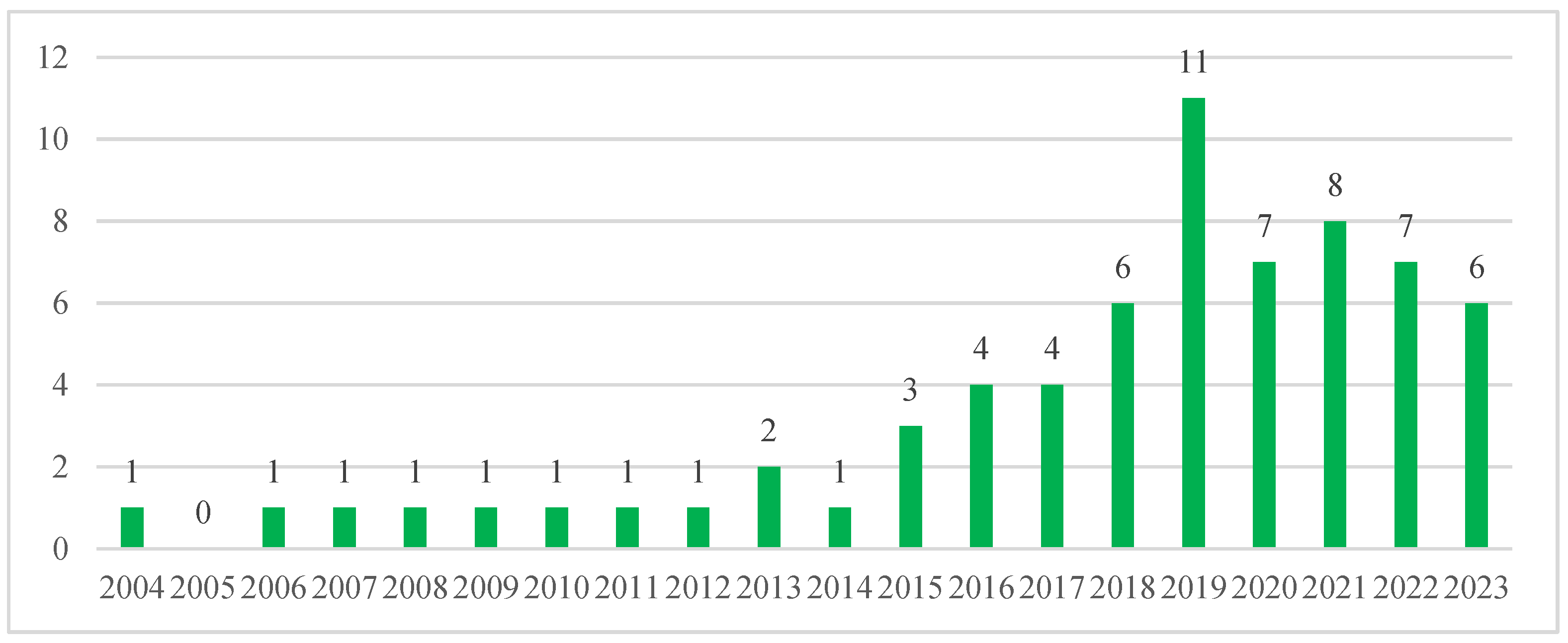

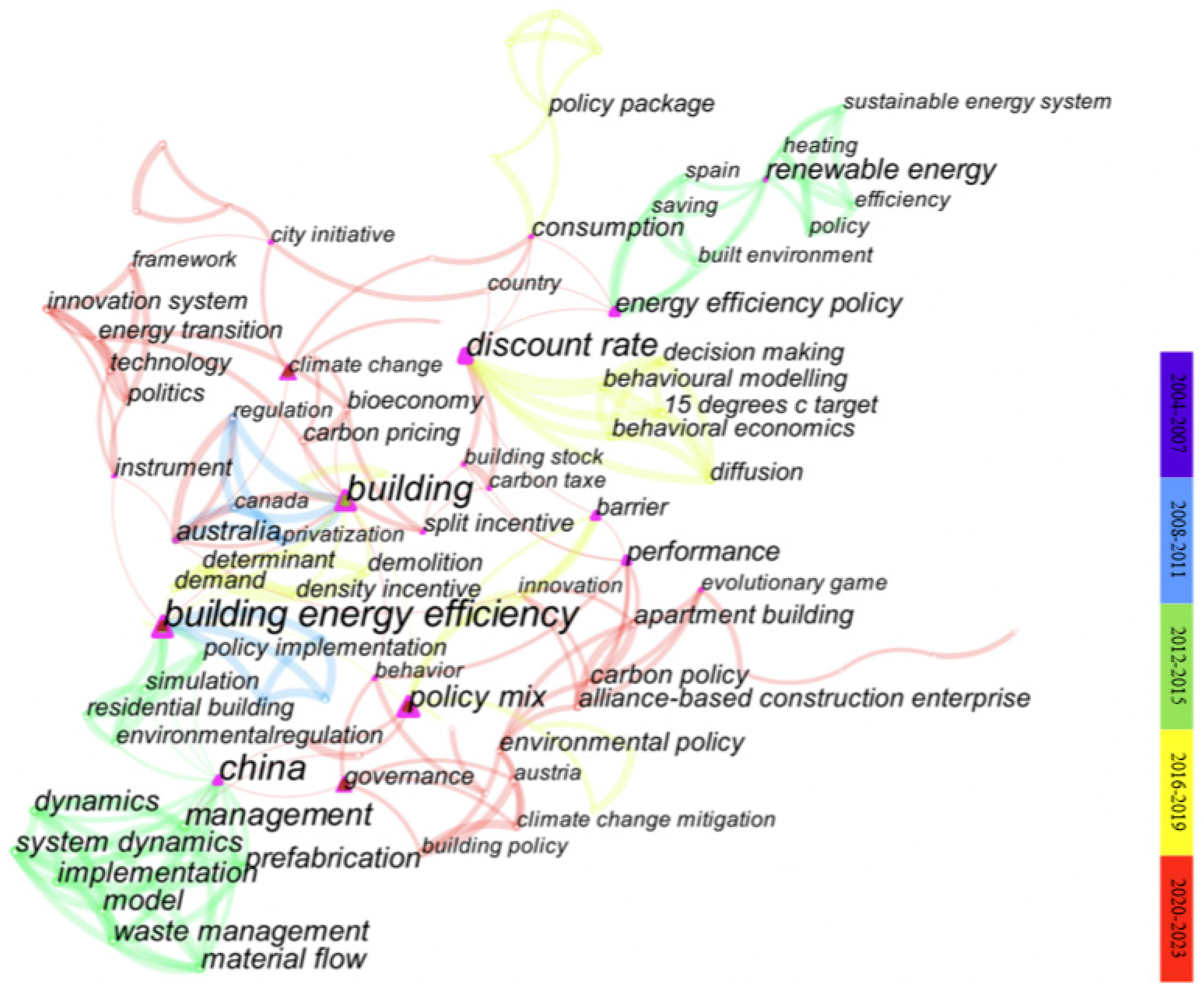
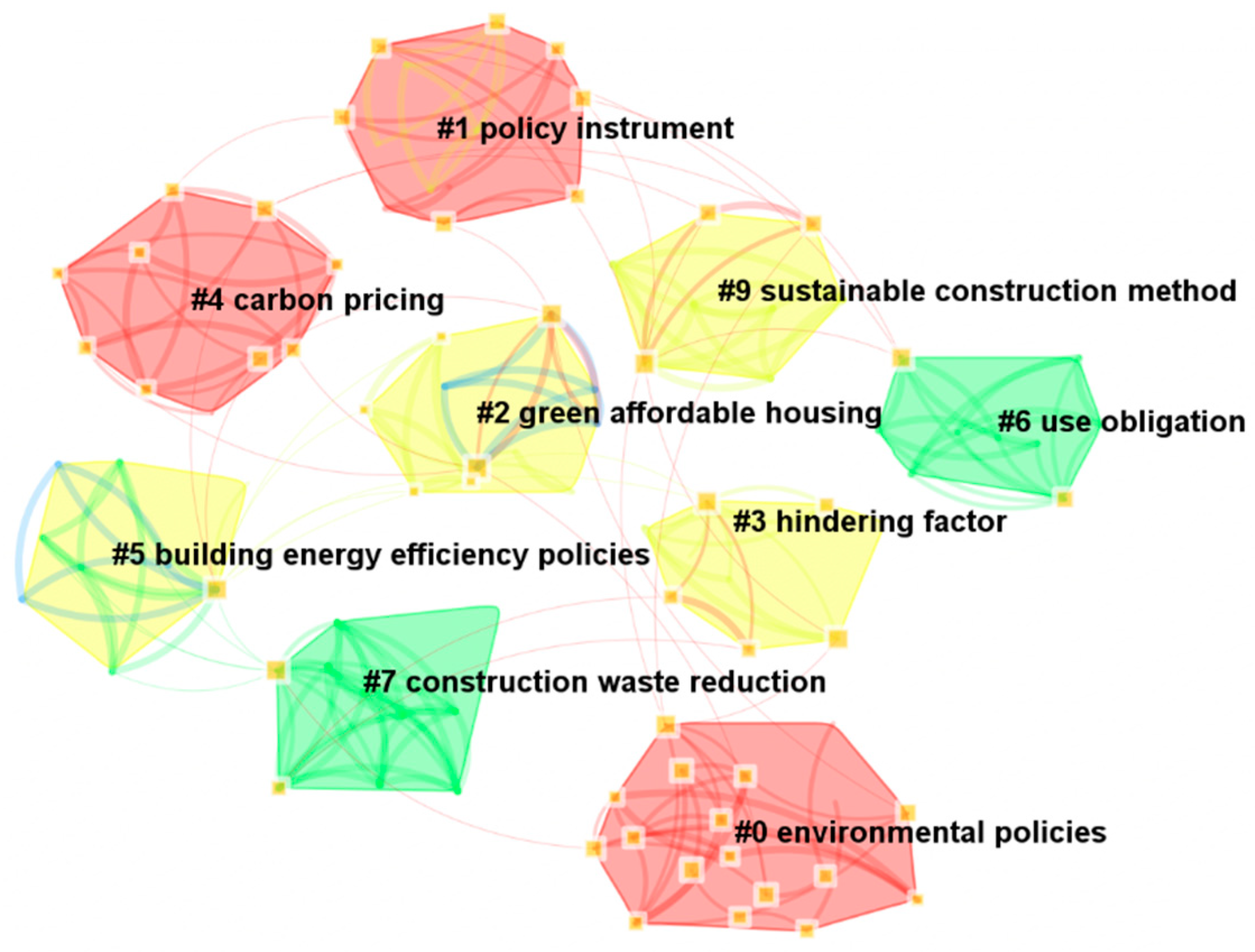

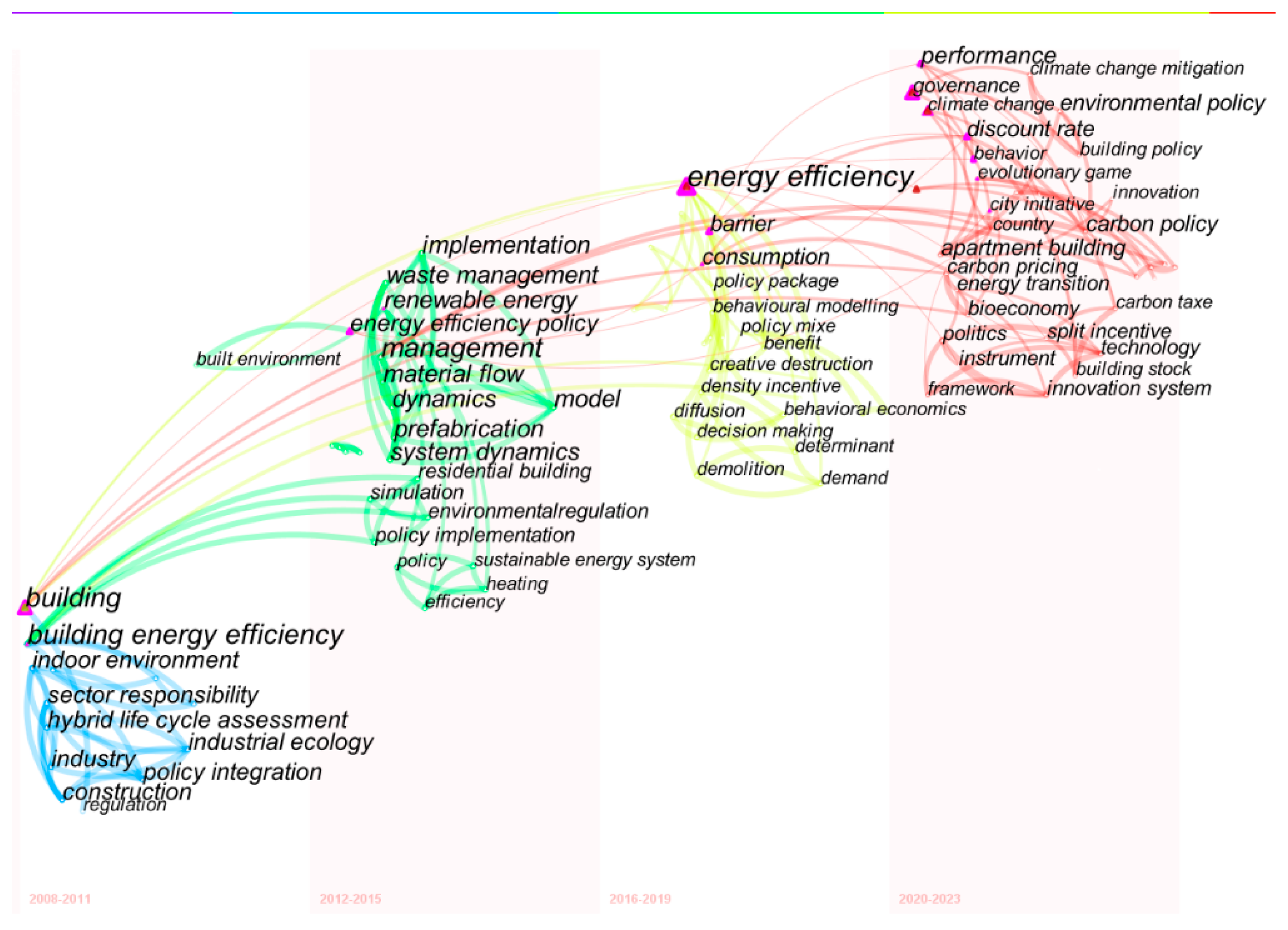
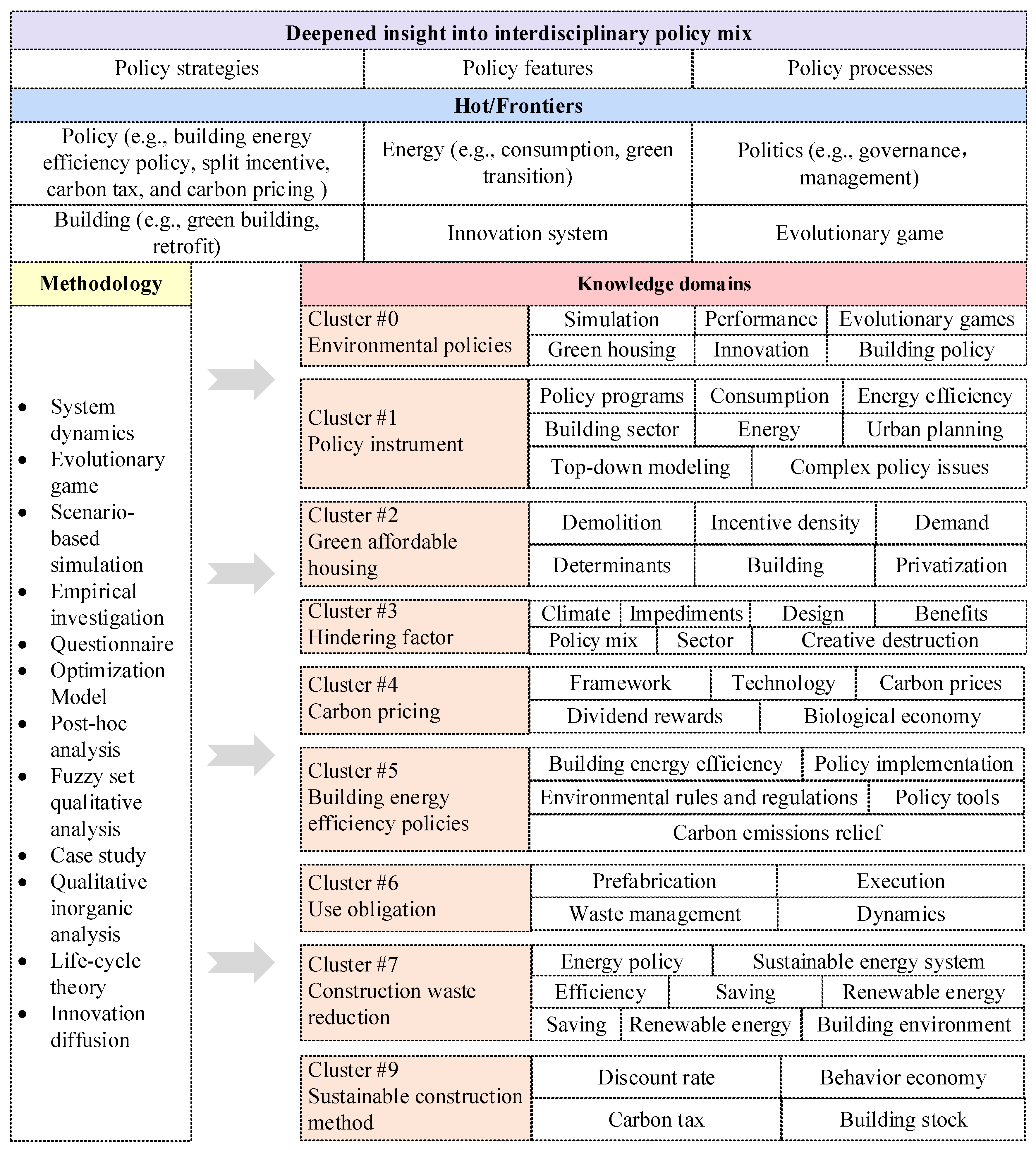
| Steps | Data Search Criteria and Guidelines |
|---|---|
| Inclusion criteria | Only academic research on BPM published in English could be included in this study. |
| This study aimed to comprehensively search for relevant studies without limitations on the time or country of publication. | |
| The data for this study were exclusively sourced from two databases, namely Scopus and WOS. | |
| Exclusion criteria | This study specifically concentrated on policy mixes within the building sector, thereby excluding studies on policy portfolios outside of the building sector or within the building sector that were not directly related to policy mixes. |
| Excluding newspapers, announcements and science propaganda materials, among others. | |
| Data search strategy | For the search process, synonym substitution was employed using the following search terms: “polic* mix*” “instrument* mix*”, “polic* portfolio*”, “polic* package*”, “polic* interplay”, “polic* interaction*”, “polic* combination*”, “polic* synerg*”, “polic* integrat*”, “building*”, and “construction*”. |
| Retrieval time | 18 May 2023 |
| Group | Keywords | Frequency | Group | Keywords | Frequency |
|---|---|---|---|---|---|
| Policy | Policy mix | 9 | Politics | Governance | 5 |
| Climate policy | 3 | Management | 3 | ||
| Energy efficiency policy | 3 | Impact | 3 | ||
| Environmental policy | 2 | Performance | 3 | ||
| Policy package | 2 | Politics | 2 | ||
| Split incentive | 2 | Energy | Building energy efficiency | 13 | |
| Region | China | 3 | Energy | 2 | |
| Australia | 2 | Energy transition | 2 | ||
| The UK | 2 | Renewable energy | 2 | ||
| Building | Building | 11 | Innovation | Innovation | 3 |
| Green building | 3 | Innovation system | 2 |
| Keywords | Strength | Begin | End | 2004–2023 |
|---|---|---|---|---|
| China | 1.19 | 2012 | 2015 | ▂▂▂▂▂▂▂▂▃▃▃▃▂▂▂▂▂▂▂▂ |
| Building energy efficiency | 0.65 | 2012 | 2019 | ▂▂▂▂▂▂▂▂▃▃▃▃▃▃▃▃▂▂▂▂ |
| Policy mix | 1.43 | 2016 | 2019 | ▂▂▂▂▂▂▂▂▂▂▂▂▃▃▃▃▂▂▂▂ |
| UK | 1.23 | 2016 | 2019 | ▂▂▂▂▂▂▂▂▂▂▂▂▃▃▃▃▂▂▂▂ |
| Climate policy | 1.23 | 2016 | 2019 | ▂▂▂▂▂▂▂▂▂▂▂▂▃▃▃▃▂▂▂▂ |
| Policy package | 0.98 | 2016 | 2019 | ▂▂▂▂▂▂▂▂▂▂▂▂▃▃▃▃▂▂▂▂ |
| Impact | 1.42 | 2020 | 2023 | ▂▂▂▂▂▂▂▂▂▂▂▂▂▂▂▂▃▃▃▃ |
| Governance | 1.4 | 2020 | 2023 | ▂▂▂▂▂▂▂▂▂▂▂▂▂▂▂▂▃▃▃▃ |
| Performance | 1.03 | 2020 | 2023 | ▂▂▂▂▂▂▂▂▂▂▂▂▂▂▂▂▃▃▃▃ |
| Framework | 1.03 | 2020 | 2023 | ▂▂▂▂▂▂▂▂▂▂▂▂▂▂▂▂▃▃▃▃ |
| Country | 0.94 | 2020 | 2023 | ▂▂▂▂▂▂▂▂▂▂▂▂▂▂▂▂▃▃▃▃ |
| Evolutionary game | 0.79 | 2020 | 2023 | ▂▂▂▂▂▂▂▂▂▂▂▂▂▂▂▂▃▃▃▃ |
| Energy | 0.79 | 2020 | 2023 | ▂▂▂▂▂▂▂▂▂▂▂▂▂▂▂▂▃▃▃▃ |
| Energy efficiency policy | 0.71 | 2020 | 2023 | ▂▂▂▂▂▂▂▂▂▂▂▂▂▂▂▂▃▃▃▃ |
| Consumption | 0.71 | 2020 | 2023 | ▂▂▂▂▂▂▂▂▂▂▂▂▂▂▂▂▃▃▃▃ |
| Retrofit | 0.68 | 2020 | 2023 | ▂▂▂▂▂▂▂▂▂▂▂▂▂▂▂▂▃▃▃▃ |
| Split incentive | 0.68 | 2020 | 2023 | ▂▂▂▂▂▂▂▂▂▂▂▂▂▂▂▂▃▃▃▃ |
| Environmental policy | 0.68 | 2020 | 2023 | ▂▂▂▂▂▂▂▂▂▂▂▂▂▂▂▂▃▃▃▃ |
| Energy transition | 0.68 | 2020 | 2023 | ▂▂▂▂▂▂▂▂▂▂▂▂▂▂▂▂▃▃▃▃ |
Disclaimer/Publisher’s Note: The statements, opinions and data contained in all publications are solely those of the individual author(s) and contributor(s) and not of MDPI and/or the editor(s). MDPI and/or the editor(s) disclaim responsibility for any injury to people or property resulting from any ideas, methods, instructions or products referred to in the content. |
© 2024 by the authors. Licensee MDPI, Basel, Switzerland. This article is an open access article distributed under the terms and conditions of the Creative Commons Attribution (CC BY) license (https://creativecommons.org/licenses/by/4.0/).
Share and Cite
Xu, Z.; Li, X.; Ma, L.; Lu, Y.; Liu, G. Unraveling the Knowledge Roadmap of Building Policy Mixes: A Scientometric Analysis. Sustainability 2024, 16, 428. https://doi.org/10.3390/su16010428
Xu Z, Li X, Ma L, Lu Y, Liu G. Unraveling the Knowledge Roadmap of Building Policy Mixes: A Scientometric Analysis. Sustainability. 2024; 16(1):428. https://doi.org/10.3390/su16010428
Chicago/Turabian StyleXu, Zhuo, Xiaohu Li, Lie Ma, Yuehong Lu, and Guo Liu. 2024. "Unraveling the Knowledge Roadmap of Building Policy Mixes: A Scientometric Analysis" Sustainability 16, no. 1: 428. https://doi.org/10.3390/su16010428





